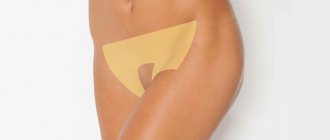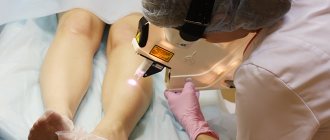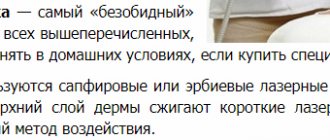The choice between photoepilation and laser hair removal often leads to a dead end - the short descriptions of the techniques are similar, it is difficult to make a choice for a simple reason - the meaning of the operation of the devices is incorrectly presented. Both methods are based on the use of a light beam, but in the first case it comes from high-energy lamps, and in the second it comes from laser radiation.
Let's look at the difference between photoepilation and laser hair removal, what principle they work on, the advantages, disadvantages and features of the technologies.
What is laser hair removal
Laser hair removal is considered a more progressive method of hair removal. It works on the same principle as photoepilation, but differs in the local spectrum of action. The energy of a narrow laser beam extends to an area of the body and affects a specific type of hair - even if its color matches the color of the skin. Heating the follicle leads to the absorption of melanin, after which the hair’s nutrition stops ().
One pulse takes a fraction of a second, and its effect extends over an area from 3 to 10 square meters. cm. The laser action covers a smaller area, so the laser therapy session lasts longer. However, the positive effect is not visible immediately, but after several weeks. This is normal - the intervals between sessions at the initial stage are 1-2 months. In the future, they are increased at the discretion of the cosmetologist.
Types of laser and photoepilation
They get their names from the type of laser used to perform the procedure. Main types:
- Diode
- Alexandrite
- Neodymium
- Ruby
- Hybrid
- CO2
- Qool (cold, cool)
The most popular photoepilation techniques:
- IPL is the very first and therefore outdated.
- SHR
- Elos (ELOS, E-light) – 2 in 1: photo and electrolysis
- A.F.T.
The most modern are SHR and AFT techniques .
The SHR technique allows you to work with the handpiece in dynamics. Flashes of light occur quickly enough for the laser hair removal specialist to move the handpiece across the entire treatment area. SHR hair removal is considered a safer and more effective photoepilation technique.
Please note: elos hair removal, due to its electro-optical synergism, is slightly more effective against blond hair than laser hair removal.
Flaws:
high price;
side effects in the form of an unpleasant tingling sensation;
possibility of burns;
need for pain relief;
no effect on light, gray hair;
allergic reactions are possible;
Pigmentation is possible on tanned skin.
Most modern lasers have all the advantages of photoepilation, but there are fewer disadvantages, including higher efficiency when epilating light hair, and a significantly lower likelihood of burns ().
How much does photoepilation cost (SHR + Elos technique)
| SERVICES | Cost, rub. | Notes |
| Price for laser facial hair removal in Krasnodar | ||
| Between the eyebrows | 500 | |
| Upper lip | 500 | |
| Forehead | 600 | Promotion -5% |
| Chin | 600 | |
| Cheeks | 700 | |
| Whiskers | 600 | |
| Neck | 1400 | |
| Full face | 2000 | Promotion -5% |
| Price for laser hair removal of hands in Krasnodar | ||
| Armpits | 800 | |
| Arms (from shoulder to elbow) | 1200 | Promotion -5% |
| Arms (from elbow to hand) | 1000 | |
| Full hands | 1600 | |
| Price for laser breast hair removal in Krasnodar | ||
| Breast (around nipple areola) | 700 | |
| Chest and décolleté area | 1600 | Promotion -5% |
| Price for laser hair removal of the abdominal area in Krasnodar | ||
| Belly (track) | 600 | |
| Full belly | 1400 | Promotion -5% |
| Price for laser hair removal of the back area in Krasnodar | ||
| Small of the back | 1600 | |
| Full back | 2900 | Promotion -5% |
| Price for laser hair removal of the bikini area in Krasnodar | ||
| Bikini classic | 1200 | |
| Laser hair removal deep bikini | 1800 | |
| Total bikini | 2700 | Promotion -5% |
| Laser hair removal of buttocks in Krasnodar | ||
| Intergluteal region | 1400 | |
| Buttocks | 1500 | |
| Price for laser hair removal of legs in Krasnodar | ||
| Full hips | 2000 | |
| Shins including knees | 1800 | |
| Full legs | 3000 | Promotion -5% |
| Complex laser hair removal | ||
| Mini: deep bikini + armpits | 1800 | |
| Midi: deep bikini + armpits + shins | 3000 | |
| Maxi: deep bikini + armpits + full legs | 3900 | Promotion -5% |
| * Subscriptions - every 6th procedure is free!!! | ||
| * When you sign up online on the website, you receive a 5% discount on any procedure!!! | ||
List of contraindications
Both procedures are considered safe in the absence of systemic diseases.
Contraindications:
- skin damage, inflammation;
- chronic skin diseases (eczema, psoriasis, dermatitis, etc.);
- benign, malignant neoplasms;
- epilepsy, diabetes mellitus;
- tuberculosis in active remission;
- period of pregnancy, lactation (breastfeeding);
- phlebeurysm;
- chronic heart and vascular diseases;
- treatment with tetracycline antibiotics;
- presence of electronic devices in the body;
- congenital sensitivity, allergy to light;
- rehabilitation period after surgery;
- a number of immune diseases;
- Age restrictions (persons under 16 years old).
Before hair removal, you should consult with your doctor and cosmetologist.
Features of photoepilation
Photoepilation is divided into four types ():
- IPL hair removal.
Impact on melanin and hair follicles with a broadband pulsed light source. The technology is used in home epilators. Most effective for light skin and dark hair. - Epilation ELOS.
A combination of laser technology and photoepilation. Highly effective for dark and fair skin. - LHE hair removal.
The procedure is based on the thermal effect on the structure of the follicle. A gentle method, but requiring a large number of sessions. Protective gels and anesthesia are not used, because... The luminous flux density is quite low.
Stages of implementation:
- The cosmetologist collects anamnesis and examines the epilation area. Gives recommendations for care, talks about the technique, the result after the session.
- The client puts on safety glasses. The skin is cleansed. If the pain threshold is low, an anesthetic gel is applied.
- The tip of the maniple makes flashes over an area of vegetation. During the session there is no visible effect, hairs do not fall out. There may be a slight burning sensation.
- The session takes from 5-7 minutes to 35-50 depending on the area of hair removal. Upon completion, a restorative, soothing agent can be applied to the skin.
Methods
Electrolysis can be performed using several methods:
- Thermolysis involves exposing the hair follicle to alternating current of high frequency and low voltage. Due to instant heating, rapid coagulation of the follicles is ensured. Thermolysis allows you to quickly treat large areas of skin. Not suitable for removing crooked hairs.
- Electrolysis involves the use of direct current. This is an electrochemical process due to which alkali and acid are formed in the hair follicles. When they react, they destroy the follicles. This method is also suitable for curly hair, but requires more time.
- Micro-Flash is an improved type of thermolysis. A current of extremely high frequency and instantaneous (in flashes) is used. The method does not require anesthesia, since the needle is completely isolated except for the tip itself.
- Bland represents a combination of the first two methods. Provides better results.
Features of laser hair removal
Several types of lasers are used in cosmetology:
- Alexandrite laser.
It has high power and requires the application of an anesthetic solution when used. Effective in eliminating dark hair on fair skin. - Ruby laser.
The laser has a short wavelength, so the procedure takes longer. Due to the high likelihood of burns, it is not performed on people with dark skin color. - Diode laser.
Well suited for epilation of any area, excellent results even on sensitive areas and light hair. Advanced solution. - Neodymium laser.
Suitable for different types of hair.
Diode technologies are the most popular. Before the procedure, the cosmetologist must select the optimal laser mode. In order to reduce pain, a gel is applied to the skin. It also serves as a “conductor” of light pulses to the cover, keeping the epithelium from overheating.
Laser hair removal can be carried out in two ways: contact and non-contact. During contact hair removal, the hardware attachment is applied to the skin itself, providing a more lasting and intense effect on the follicles. With contactless hair removal, this distance is reduced - a technique for working on sensitive areas.
Advantages and disadvantages
The technique has the following advantages:
- the use of several types of lasers of different powers allows you to effectively treat the required area of skin;
- safety for health and skin in case of professionalism of a specialist and high-quality equipment;
- minimum pain;
- longer lasting results than with photo hair removal;
- absence of ingrown hairs and skin redness;
- affordable price.
Disadvantages include:
- limited options regarding hair color;
- Often, in order to reduce the cost of the procedure, low-quality Chinese-made equipment is installed in salons, which can harm the patient’s health;
- the need to grow hairs of a certain length;
- does not involve permanent hair removal;
- the need to repeat hair removal to maintain the effect;
- insufficient knowledge of the method;
- risk of burns if the procedure is not performed correctly.
Electrolysis
TOP 5 myths about photoepilation and laser hair removal
Myth No. 1. Hair removal is harmful to health
The laser specifically hits the area of the hair follicle with a high melanin content, the beam penetration depth is only a few millimeters! Internal organs are not affected ().
The only side effect that may occur after the procedure is redness of the area, similar to what can be obtained as a result of tanning under the sun. Let's say more - redness is the first sign of successful hair removal. It goes away over several hours.
…
Myth No. 2. Epilation leads to scarring
Scarring is possible only if there are errors in electrolysis. Neither photoepilation nor laser hair removal entails a violation of the integrity of the integument, therefore they do not leave any marks on the body (). Ingrown hairs do not appear after hardware methods, but are possible after mechanical removal. For example, clients often come after waxing or sugaring for laser hair removal to fix the problem.
…
Myth No. 3. High cost of the procedure
The cost of hair removal is a relative concept. It depends on the skill level of the specialist, the area of the procedure, and the complexity of the work. Yes, to achieve a lasting effect, it is recommended to undergo several hair removal sessions with a cosmetologist. However, after you get a lasting result, you will understand that the result more than pays off. When analyzing your expenses, do not forget to take into account how much money is spent per year on the purchase of razors, creams, foams and other home hair removal products.
…
Myth No. 4. Hair removal procedure is painful
Everyone's pain threshold is individual. Photoepilation and laser hair removal cause unpleasant sensations - they can be compared to slight tingling, clicking on the skin, vibration. However, they do not cause pain and in most cases are tolerated without any problems. When removing hair from intimate places that are highly sensitive, a cosmetologist can use an anesthetic cream ().
…
Myth No. 5. The amount of hair after epilation increases
A lie invented by impatient people. The hairs that sprouted after epilation become much softer and lighter. By the third session, their number decreases by half, and later they disappear completely.
Advantages and disadvantages of elos
This technique has a lot of advantages, among which are:
- makes it possible to remove hair from any area of the skin;
- efficiency;
- suitable for any skin type, even with minor pigment spots;
- stimulates the production of collagen and elastin;
- no burns with proper technology;
- There is no need to grow hair to undergo a session.
The disadvantages of the procedure include:
- high price;
- to maintain the effect it is necessary to repeat the procedure regularly;
- the relative pain of the procedure, for example, compared to the laser type;
- the method is contraindicated during pregnancy, menstruation and the lactation period;
- hair removal when using Elos occurs for a short time - up to a maximum of 1-2 years, as with most methods;
- this technique does not remove the follicle, but only damages it, since destruction requires strong heat, which causes burns;
- the occurrence of burns due to improper setup of the device and its use;
- elos may not have the desired effect when removing light hairs, in the presence of hormonal disorders, on dark skin.
Elos hair removal has a simple operating principle: a specialist treats the required area of skin with an antiseptic, applies a special gel and removes hairs using an applicator.
Photoepilation
This hair removal method is suitable exclusively for dark-haired women with fair skin, since light, gray and red hairs contain a minimal amount of melanin and do not absorb photons of light. Hair removal is carried out by focusing an intense beam of light (IPL), which absorbs melanin and converts it into heat, which eliminates the stem cells responsible for hair growth.
Photoepilation allows you to gradually reduce the number of hairs by up to 70 percent. This procedure can be a good alternative for women who have contraindications to laser and electrolysis, but unlike them, it is less effective.











